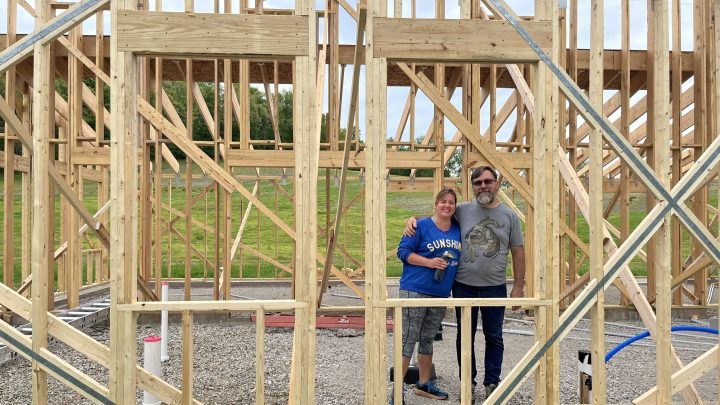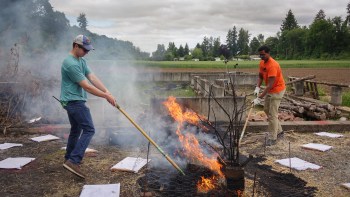
The economic and logistical realities of straw-bale building
The economic and logistical realities of straw-bale building

David and Carrie Chew live in a house made of straw. It has two bathrooms, a modern kitchen and a packed earthen floor. The exterior walls are made with stacked wheat straw bales covered in plaster.
“It’s not a new technology,” said David Chew. “It’s something that’s been done for hundreds of years.”
Proponents of modern straw-bale construction highlight the sustainability of sourcing materials from local farms and natural insulation provided by straw.
“The thermal mass basically stabilizes your temperature through day and night and the thickness then reduces sound,” said David Chew.
As thermal regulation and sustainable construction become increasingly urgent problems in the face of climate change, there is growing interest in natural building materials. But the Chews say it’s important for people to understand the tradeoffs.
“Straw-bale or alternative building is an absolutely fantastic experience,” said David Chew. “But it’s not — I would not recommend this to anybody who wasn’t already interested.”

David Chew, an accountant and business consultant, and his wife Carrie, an eighth-grade math teacher, had been thinking about an alternative building project for years but seriously began plotting it during the pandemic.
“We started talking about ‘well, maybe, maybe,’ and then that ‘maybe’ turned into buying property and then buying 800 bales of straw and stacking those bales of straw and here we are,” said Carrie Chew.
The couple attended workshops and bought property in Knox County, Ohio.
They found a builder experienced in building farm structures but did much of the design and a significant portion of the labor themselves. “The architect bailed after the first few meetings, so we were pretty much on our own after that,” said David Chew.
“It got a little bit technical with having to carve out the straw bales to kind of make them fit together like Legos,” said Carrie Chew. “I had straw in places that you would never think straw would get to by the end of every single day.”
The materials for straw-bale construction are generally cheaper than insulation and drywall in a modern house, but there are higher labor costs. “And then it comes down to the same problem of any house: How much customization do you have?” said David Chew.
The Chews knew they wanted a modern kitchen, bathrooms, high-quality windows and other higher-cost features.
To finance the project, they initially took out credit cards with zero interest for 12 months or more. “We couldn’t get the financing through traditional means because it wasn’t a traditional house,” said David Chew.

Once they sold their previous home in Columbus, the Chews were able to pay off the credit cards and continue construction until they had enough of a structure to convince a local bank to give them a traditional construction loan. “You’re not going to get financing for a straw-bale house from a blueprint because it’s something that it’s not going to check the boxes for a loan,” said David Chew.
According to the California Straw Building Association, the lifetime of straw in a building could be anywhere from three weeks to nine thousand years, depending on moisture exposure and how well the building is constructed and maintained. “Here, the straw is gonna last for 50 years or more,” said David Chew. “And it’s something that you could readily replace with material that is all in the area.”
During construction, the Chews lived onsite in an RV. “We were creeping up on the winter,” said David Chew. “Every day [was] a race against the weather to finish it to the point where we [could] move in.”
When they finally did move in last November, there was no functional shower and only a cardboard wall surrounding the bathroom. “I remember us both just sitting on the couch looking at each other with this kind of half-crazed smile and almost tears in our eyes,” said Carrie Chew. “We were so grateful to just be in a house.”
Almost one year later, the Chews still have work to do. One sink still isn’t working, there are walls that need plaster, and various cosmetic projects. “But it’s okay that it’s not finished yet because every day is the adventure of learning something new,” said Carrie Chew.
Tell us your real estate or housing story using the form below, and you may be featured on a future edition of “Adventures in Housing.”
There’s a lot happening in the world. Through it all, Marketplace is here for you.
You rely on Marketplace to break down the world’s events and tell you how it affects you in a fact-based, approachable way. We rely on your financial support to keep making that possible.
Your donation today powers the independent journalism that you rely on. For just $5/month, you can help sustain Marketplace so we can keep reporting on the things that matter to you.


















